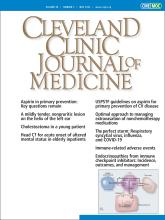
Are we done with the issue of aspirin (ASA) for primary prevention of cardiovascular (CV) events? Not quite yet. Important questions remain.
ASA for secondary prevention, ie, after an initial CV event, is well entrenched in medical practice,1 despite the fact that the baseline pharmacotherapy for patients with a CV event is markedly different than it was 2 decades ago. Aggressive lipid-lowering therapy with attention to control of hypertension is now an expectation. It is hard to imagine performing a large-scale placebo-controlled trial to reevaluate the benefit of ASA in secondary prevention.
For ASA as antiplatelet therapy in primary prevention of CV events, as discussed by Mallick et al2 in this issue of the Journal, the published data and guidelines on the limited net value are generally consistent: cardiovascular benefits achieved are small, and the bleeding risks seem higher than many of us assumed.
The studies are seemingly large enough to detect significant benefit even if the “event” rate is low. Assuming that the degree of benefit from ASA in secondary prevention is still robust, and recognizing the caveat that I note above regarding baseline therapy, shouldn’t there be net benefit from antiplatelet therapy at preventing type 1 ischemic events? Reasoning in the guidelines for discouraging the general use of ASA as a primary preventive agent comes not only from the limited benefit, but also from the relatively high rate of bleeding in patients on low-dose ASA. Bleeding risk seems to increase with age. In the Dallas Heart Study3 of 2,191 patients, the likelihood of a bleeding event was increased further in patients who had an increased risk for coronary events as indicated by their coronary artery calcium (CAC) score—the very patients who conceptually might achieve greater benefit from effective prophylaxis.
I wonder if the ultimate risk-benefit ratio of ASA for primary prevention would be sufficiently altered if all patients prescribed ASA were also given high-dose proton pump inhibitor therapy in an effort to reduce gastrointestinal bleeding. But I am more intrigued by trial demographic factors and vascular biology that might have impacted the documented protective response to ASA in the reported studies, and how this can influence how we discuss primary prevention with our patients.
Most large, timed, observational studies excluded patients who were already taking ASA. Thus, patients who had been perceived by their physicians or by themselves to be at higher risk for CV events may not have been enrolled in studies. The US Preventive Services Task Force (USPSTF) recommendations are divided in part on patient age (age increases bleeding risk) with an effort to risk-stratify asymptomatic patients in order to determine which patients would most benefit from a shared decision-making discussion with their physicians. The USPSTF proposed (with limited enthusiasm) an estimated 10% risk of a CV event over 10 years in patients ages 40 to 59, using the American College of Cardiology/American Heart Association (ACC/AHA) assessment of cardiovascular risk,4 as the trigger for this discussion. Notably, this risk tool does not include family history, markers of inflammation, or advanced coronary imaging. Advanced imaging has been suggested as helpful in further identifying patients who would benefit from primary prevention with ASA.3
As to vascular biology and the apparent differential effect of ASA in secondary vs primary prevention, might there be fundamental prostanoid-dependent differences in some patients with atherosclerotic (or non-atherosclerotic) disease who develop events and those who don’t? I found no evidence for this, but perhaps in patients without advanced disease it takes much longer for the ASA effect to be demonstrated.
The 2022 USPSTF guidelines discourage use of ASA in those over age 60, while the 2019 ACC/AHA guidelines2 advise patient dialogue in those ages 60 to 70. Both guidelines say to avoid ASA in those over age 70, despite the fact that those patients, even if asymptomatic, would seemingly be more likely to have accumulated significant CV disease and thus would be more likely to benefit from ASA.
While the age-associated increased risk of bleeding must be accounted for, achieving greater reliability in identifying patients at higher risk for CV events would better inform our discussions with patients. I mentioned the use of CAC scoring above, and a recent Danish study of 9,533 asymptomatic patients over age 40 (mean age 60) used coronary computed tomography angiography to demonstrate the presence of nonobstructive coronary artery disease in 36% and obstructive coronary artery disease in 10% of participants.5 Those with asymptomatic obstructive disease had an 8-fold increase in myocardial infarction. But it remains to be seen if identifying patients with asymptomatic but significant coronary artery disease by CAC scoring, computed tomography angiography, or other modalities will enhance the effective use of ASA (in addition to aggressive statin use). For now, when following the current guidelines, the question of how best to assess CV risk will continue to arise in shared decision-making discussions with our patients.
- Copyright © 2023 The Cleveland Clinic Foundation. All Rights Reserved.






